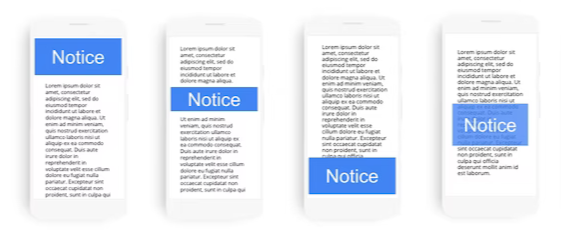避免干擾性的插頁式廣告和對話方塊

使用干擾性插頁式廣告和對話方塊的目的通常是為了宣傳,但這類網頁元素會妨礙使用者瀏覽內容。插頁式廣告會覆蓋住整個網頁,而對話方塊只會覆蓋網頁的一部分,以重疊的形式顯示,有時也會讓底下的內容變得難以瀏覽。
網站常會基於各種原因而需要顯示對話方塊;然而,使用干擾性插頁式廣告阻礙使用者瀏覽可能會讓使用者感到困擾,破壞他們對網站的信任度。
干擾性的對話方塊和插頁式廣告會讓 Google 和其他搜尋引擎難以解讀您的內容,進而導致搜尋成效不佳。同樣地,如果使用者覺得您的網站難以使用,很可能就不想再造訪您的網站,無論是直接造訪或是透過搜尋引擎。
建立非干擾性對話方塊
建立不會造成干擾的對話方塊,意味著使用者在瀏覽您的內容時不會遭到對話方塊阻礙。這項做法適用於各種宣傳對話方塊,包括應用程式安裝提示。遵循以下這些最佳做法有助於網站提供優質的使用者體驗,同時也能讓 Google 搜尋瞭解您網站的內容和結構。
以橫幅取代插頁式廣告

不要使用占據整個網頁的插頁式廣告,改以只占用局部畫面的橫幅廣告來吸引使用者注意。橫幅能讓使用者和搜尋引擎在到達網頁時立即取得相關內容。
您能夠以多種方式來導入這類橫幅。舉例來說,如果要顯示應用程式安裝橫幅,可以使用瀏覽器支援的橫幅廣告,例如 Safari 的智慧型應用程式橫幅廣告或 Chrome 的應用程式內安裝體驗。另一個方法是建立 HTML 橫幅,這與一般小型廣告類似,可連結至正確的應用程式商店,讓使用者下載應用程式。如有需要,您可以將這些小型容器重複使用於其他通知,例如電子報訂閱提示。
使用常見的程式庫
許多 CMS 都會提供外掛程式,可用來建立適用於常見用途的標準對話方塊和插頁式廣告,例如電子報訂閱提示。舉例來說,如果您使用 WordPress,可以搜尋「電子報訂閱 Wordpress」。由於外掛程式開發人員可以大規模部署改善項目,因此使用這類外掛程式將有助於 Google、其他搜尋引擎作業,對整體網際網路來說也有助益。
避免常見錯誤
除非是法律規定,否則在設計對話方塊或插頁式廣告時,請避免下列常見錯誤,以利 Google 搜尋能順利檢索及解讀您的內容:
- 請勿以插頁式廣告遮蓋整個網頁。
- 徵求使用者同意或要求提供資訊時,請勿將使用者重新導向至其他網頁。
依法顯示的插頁式內容
部分網站會因為發布的內容類型而需要顯示插頁式內容。例如,賭場網站可能需要顯示年齡管制關卡,要求使用者先提供年齡才能瀏覽內容。
依法規定的插頁式內容不需遵守本文所述的規範;不過,還是建議網站盡可能遵循下列最佳做法:
- 確認內容與插頁式廣告重疊。這麼做可確保 Google 至少能夠檢索部分內容,並有機會顯示在搜尋結果中。
- 請勿為了收集同意聲明或提供資料,而將連入 HTTP 要求重新導向至其他網頁。如果將所有網址重新導向至單一網頁,會導致只有重新導向後的網頁能出現在搜尋結果中,因為 Googlebot 只會擷取該網頁。
對於必須通過年齡管制機制才能觀看的成人使用者內容,建議讓 Googlebot 在不觸發這個機制的情況下檢索您的內容,方法是驗證 Googlebot 要求,並在沒有年齡管制的機制下提供內容。
